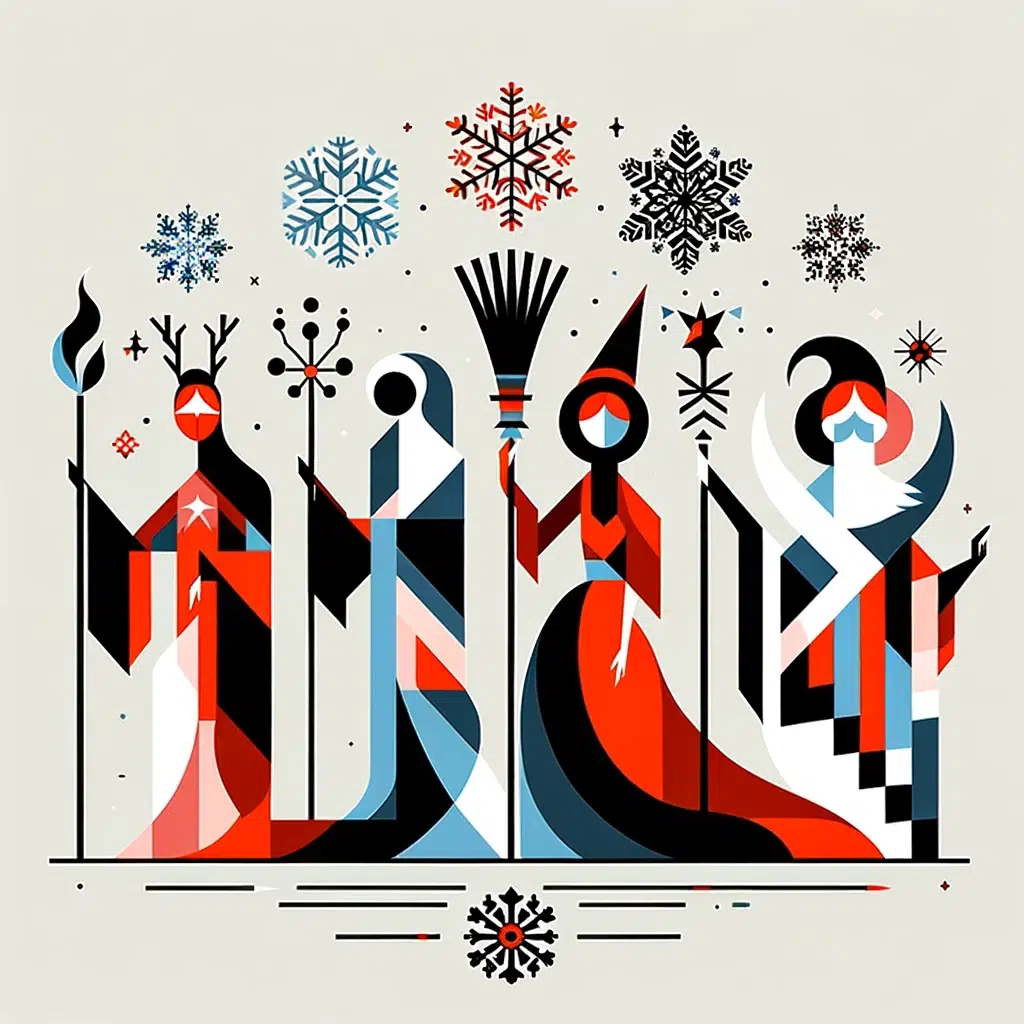If Santa Claus had a profile on a social network, he would have millions of followers, hanging on to his snowy adventures and updates from the elves’ workshop. But what about his female counterparts, often unknown to the general public ? These ladies, far from being mere accessories in Christmas tales, are complete figures, steeped in traditions and legends. From Mother Christmas, a maternal and benevolent figure, to the mysterious Befana traversing the Italian skies, these women embody the diversity and richness of year-end traditions. They not only bring a touch of magic and history to our celebrations but also a strength and independence that challenge stereotypes. So, in this festive season, let’s take a moment to discover and celebrate these female figures of the holidays who deserve our attention.
Mother Christmas, More than a Companion
Imagine managing Santa Claus’s workshop, coordinating the elves, and keeping the reindeer in order—literally and figuratively. That’s Mother Christmas for you, a leading figure in the hustle and bustle of the polar workshop. But who is she really? According to various traditions, Mother Christmas first appeared in tales and poems in the 19th century. She was initially depicted as Santa’s kind and caring wife, often in the background but with an undeniable presence.
Over time, Mother Christmas has evolved from a mere supportive role to an equal partner of Santa Claus. In some stories, she is even portrayed as the architect behind gift lists and distribution plans, bringing order and efficiency to the workshop. Her image is that of an ultimate multitasker, whose independence and strength of spirit rival her legendary kindness.
However, the full recognition of Mother Christmas as a figure of autonomy and strength is not yet a universal reality.
Imagine not limiting her to a domestic figure. Mother Christmas would then become a symbol of female empowerment, reflecting societal evolutions and struggles for gender equality. She would embody the ability to juggle multiple responsibilities while bringing warmth and joy to the holiday season. She would represent not only Santa’s indispensable partner but also a complete figure, inspiring generations with her wisdom, ingenuity, and compassion. Rather than remaining in the shadow of her famous husband, Mother Christmas could shine with her own radiance, becoming a source of inspiration and a role model for all.
Befana, the Benevolent Witch of Italy
The Befana, this flying Italian witch, has no trouble when it comes to distributing gifts. Better than express delivery, she glides through the night on her broom, defying the laws of gravity and modern logistics. But who is this witch who seems to have found the secret to eternal youth?
Her story draws its roots from ancient Roman traditions, including the Saturnalia, a festival where roles were reversed and gifts were exchanged. Add a dash of Christian folklore—the Befana supposedly declined the Magi’s offer to accompany them to Bethlehem, then, ridden with remorse, wandered to find the baby Jesus, offering gifts to all children in hopes of finding the right one.
But make no mistake, beneath her old lady appearance, the Befana is a true fairy of modern times. She proves that age is just a number, especially when it comes to spreading joy (and a few sweets). And for those who haven’t been so good, she has a little something in her bag—not-so-sweet coal, reminding that even witches have a sense of justice.
In Italy, she is celebrated not only as a gift distributor but also as a symbol of renewal and wisdom. After all, who else can boast of navigating the nighttime sky, defying age stereotypes while keeping a smile, even after descending countless chimneys?
Saint Lucy, the Light of Scandinavia
In Scandinavian homes, Saint Lucy is much more than a mere distributor of light and saffron buns; she is a true rock star of the winter season. This celebration, taking place on December 13, originates from the historical Saint Lucy, a Christian martyr whose name means “light.” She is renowned for secretly bringing food to persecuted Christians, her crown of candles allowing her to keep her hands free for more provisions.
But Saint Lucy is not just a figure of generosity and sacrifice; she is also a demonstration that even in the heart of the Scandinavian winter, where the sun seems to have hit the “snooze” button a bit too long, a glimmer of hope and warmth can pierce the darkness. And all this, she accomplishes without the need for an army of elves or flying reindeer. Who needs magic when you have candles and unwavering determination?
In Scandinavia, Saint Lucy’s Day is an occasion for luminous processions, where girls and boys, dressed in white and crowned with lights, sing in honor of this legendary saint. It’s a bit like the Coachella festival, but with more candles and less electronic music. A tradition that warms the heart and illuminates the spirit, proving that sometimes, the real heroes of winter don’t wear capes but rather a crown of candles.
Frau Holle, the German Winter Goddess
In German folklore, Frau Holle, or Lady Winter, is the one who takes control of winter weather, but in a more poetic way than any weather forecast. According to legend, when she vigorously shakes her pillows and duvets, snow begins to fall on the world below. Forget weather forecasts and satellites; Frau Holle knows how to transform a dull landscape into a winter wonderland in the blink of an eye.
But where does this magical figure come from? Frau Holle finds her roots in ancient Germanic and Norse mythologies. She was venerated as a protective goddess of the home and fertility, often associated with the cycles of life and death. In some stories, she is even described as the guardian of the realm of the dead, adding a touch of mystery to her already fascinating character.
While some eagerly await a white Christmas, Frau Holle is not idle. She puts her whole heart (and pillows) into creating a winter landscape worthy of the most beautiful postcards. And she does it with an efficiency that would make meteorological services green with envy.
In Germany, she is a beloved figure in fairy tales, representing powerful and maternal nature. She teaches that every snowflake has its place and importance, much like people in society. So, the next time you see snow falling, think of Frau Holle, who, with a simple wave of her hand, transforms the world into an enchanted winter landscape.
Snegurochka, Russia’s Snow Maiden
Snegurochka, also known as the Snow Maiden, is not just the refreshing sidekick of Ded Moroz (the Russian Father Frost); she is a star in her own right in Russian winter festivities. But where does this charming ice maiden come from? According to legend, Snegurochka is born from the snow itself. In one of the most popular versions of her story, she is fashioned by an elderly childless couple who ardently wished for a child. Their wish is granted when their snowman comes to life as a beautiful girl, emerging as a winter miracle.
But Snegurochka is much more than a mere animated snow sculpture. She is often depicted as Ded Moroz’s granddaughter, accompanying the great frosty man in his travels across Russia to bring gifts to children. She embodies the beauty of Russian winter with her sparkling snow dress and her gentle and joyful character.
This frosty figure adds a touch of magic to every celebration, and not just because she comes from the Russian cold. As Ded Moroz’s partner, Snegurochka proves that behind every great frosty man, there is indeed an icy but incredibly fantastic woman. She reminds children and adults alike that the magic of winter is alive and well, and that sometimes, fairy tales can slip into our reality.
In Russia, Snegurochka is an iconic figure in New Year’s celebrations, embodying the festive spirit and joy of the season. She is a reminder that even in the biting cold, the warmth of joy and conviviality can always find its place.
Mari Lwyd, a Mysterious Welsh Tradition
The Mari Lwyd, an ancient Welsh tradition, is proof that festivities can be both spooky and incredibly fun. Imagine a singing phantom horse, adorned with ribbons and carrying a wicker horse’s head, showing up at your doorstep. Yes, it may sound like the recipe for a horror movie, but in Wales, it’s simply a traditional and rather eccentric way to wish “Happy Holidays”!
But where does this unusual tradition come from? Mari Lwyd dates back to pre-Christian pagan celebrations and is closely tied to winter solstice festivities. The name “Mari Lwyd” itself means “the gray mare” in Welsh and may symbolize an ancient fertility spirit or a carnival figure meant to drive away the bad spirits of the past year.
During this celebration, groups of villagers, accompanied by Mari Lwyd, go around local houses, engaging residents in improvised verbal jousts and songs. If Mari Lwyd wins, she is invited in, bringing good fortune for the upcoming year.
Thus, while the idea of a singing phantom horse at your door may seem a bit strange these days, Mari Lwyd is actually a charming Welsh tradition, blending humor, creativity, and a touch of the supernatural to celebrate the end of the year. So, if you hear a horse singing Christmas carols in Welsh, don’t worry, it’s just Mari Lwyd, bringing wishes of happiness and prosperity.
These ladies of the festive season prove that the holidays are not just a matter of men in red. They bring diversity, magic, and, let’s admit it, a welcome touch of madness to our traditions.
So, the next time you hear jingles, think of those who might be behind the reins: one of these extraordinary ladies, orchestrating the magic of Christmas with the efficiency of a holiday CEO.
This holiday season, between a cookie and a glass of milk left for Santa Claus, why not leave a thank-you note for all these fabulous women who make our holidays so special? After all, behind every great man in red, there are a multitude of extraordinary women, each adding her own pinch of salt (or sugar) to make the magic of Christmas happen.

